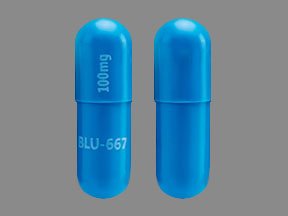Pralsetinib and Alcohol/Food Interactions
There are 2 alcohol/food/lifestyle interactions with pralsetinib.
Pralsetinib Food/Lifestyle
Major Food Interaction
Food should not be consumed for at least 2 hours before and at least 1 hour after taking pralsetinib. Do not consume grapefruit, grapefruit juice, any supplements that contain grapefruit, Seville oranges, or Seville orange juice as these products can increase the blood levels of pralsetinib. This may increase the risk and/or severity of serious side effects such as lung problems, liver problems, high blood pressure, fatigue, muscle and joint pain, and bleeding complications. Some sources also warn that combining these medicines could increase the risk of an irregular heart rhythm that may be serious and potentially life-threatening, although it is a relatively rare side effect. You may be more susceptible if you have a heart condition called congenital long QT syndrome, other cardiac disease, conduction abnormalities, or electrolyte disturbance (for example, magnesium or potassium loss due to severe or prolonged diarrhea or vomiting). Talk to your doctor if you have any questions or concerns. It is important to tell your doctor about all other medications you use, including vitamins and herbs. Do not stop using any medications without first talking to your doctor.
Switch to professional interaction data
Pralsetinib High Blood Pressure (Hypertension)
Moderate Potential Hazard, Moderate plausibility
pralsetinib - hypertension
Hypertension has been reported in patients in treatment with pralsetinib. This drug should not be initiated in patients with uncontrolled hypertension. Caution and close monitoring is advised.
Switch to professional interaction data
Pralsetinib drug interactions
There are 721 drug interactions with pralsetinib.
Pralsetinib disease interactions
There are 4 disease interactions with pralsetinib which include:
More about pralsetinib
- pralsetinib consumer information
- Check interactions
- Compare alternatives
- Side effects
- Dosage information
- During pregnancy
- Drug class: multikinase inhibitors
- Breastfeeding
- En español
Related treatment guides
Drug Interaction Classification
| Highly clinically significant. Avoid combinations; the risk of the interaction outweighs the benefit. | |
| Moderately clinically significant. Usually avoid combinations; use it only under special circumstances. | |
| Minimally clinically significant. Minimize risk; assess risk and consider an alternative drug, take steps to circumvent the interaction risk and/or institute a monitoring plan. | |
| No interaction information available. |
See also:
Further information
Always consult your healthcare provider to ensure the information displayed on this page applies to your personal circumstances.


